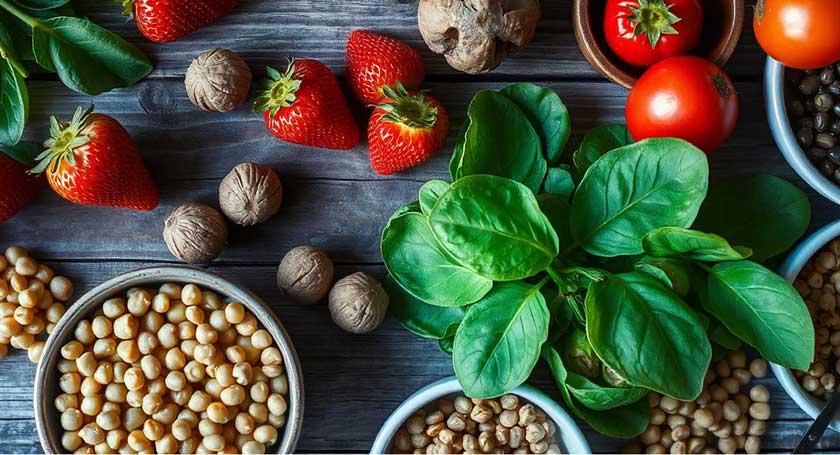Eating a balanced diet is essential for maintaining health, and incorporating seasonal ingredients can make it easier, more affordable, and far more enjoyable. Seasonal ingredients aren’t just fresher and tastier; they also align with what our bodies need at different times of the year, providing us with essential nutrients when we need them most. In this post, we’ll explore the benefits of eating seasonally and how to create a balanced diet using ingredients that are in peak season.
Why Choose Seasonal Ingredients?
1. Better Nutrition and Freshness
Seasonal fruits and vegetables are harvested at their peak, meaning they’re fresher and packed with more nutrients. For example, strawberries and tomatoes in summer are full of flavor and nutrition, while winter greens like kale and Brussels sprouts bring immune-boosting vitamins to help you stay healthy during colder months.
2. Support Local Farmers
Buying seasonal ingredients often means supporting local farmers, which is beneficial for the environment and the economy. Local produce has a smaller carbon footprint and is generally more affordable since it doesn’t require lengthy transportation.
3. Cost-Effective
Seasonal ingredients are often more affordable since they’re abundant. As supply increases, prices drop, making it easier on your wallet to stick to fresh, healthy food.
Building a Balanced Diet with Seasonal Ingredients
A balanced diet includes a variety of nutrients from different food groups. Here’s a breakdown of how to build a well-rounded diet using ingredients that align with each season.
Spring: Light, Leafy, and Fresh
As spring brings warmer weather, our bodies naturally crave lighter, refreshing foods. Look for leafy greens, tender vegetables, and early fruits like strawberries and rhubarb.
- Proteins: Grilled salmon or roasted chickpeas add healthy protein.
- Carbohydrates: Incorporate whole grains like quinoa or barley for sustained energy.
- Fats: Avocados are abundant in spring and provide a healthy source of fats.
- Recipe Idea: Spring Salad with Strawberries, Spinach, and Walnuts – A vibrant salad packed with antioxidants, fiber, and healthy fats.
Summer: Hydrating and Cooling Foods
In summer, focus on hydrating and cooling ingredients. Fresh fruits, juicy vegetables, and lighter proteins like fish and chicken are perfect for keeping your body nourished and energized.
- Proteins: Grill up some chicken or tofu for lean protein.
- Carbohydrates: Corn, zucchini, and bell peppers are fantastic and naturally sweet summer options.
- Fats: Use olive oil for dressings or grill vegetables in it.
- Recipe Idea: Grilled Veggie and Quinoa Bowl – Combine grilled zucchini, bell peppers, and cherry tomatoes with quinoa for a refreshing and nutrient-packed meal.
Fall: Hearty, Warming Foods
Fall is the time to shift toward heartier foods that offer warmth and grounding. Root vegetables, squash, and apples become available and are ideal for comforting, nutrient-dense meals.
- Proteins: Lean meats like turkey or plant-based options like lentils.
- Carbohydrates: Root vegetables like sweet potatoes and beets provide complex carbs.
- Fats: Nuts and seeds add richness and warmth to meals.
- Recipe Idea: Roasted Root Vegetable Stew – Roast sweet potatoes, carrots, and parsnips, then combine them with lentils for a filling, comforting stew.
Winter: Nutrient-Dense and Immune-Boosting Foods
Winter calls for foods that help boost immunity and keep us warm. Dark leafy greens, cruciferous vegetables, and citrus fruits come into season, providing vitamins and antioxidants.
- Proteins: Enjoy hearty proteins like beef or plant-based options like chickpeas.
- Carbohydrates: Squash and winter root vegetables are satisfying and full of fiber.
- Fats: Use coconut oil or butter for cooking warm, rich dishes.
- Recipe Idea: Kale and Butternut Squash Soup – A warming soup filled with vitamins, minerals, and a comforting flavor.
According to the Harvard T.H. Chan School of Public Health, eating a variety of seasonal fruits and vegetables can help ensure that you’re getting the full spectrum of nutrients your body needs. Seasonal produce is also often grown closer to home, meaning it retains more of its nutrients by the time it reaches your table.
Tips for Eating Seasonally Year-Round
- Plan Your Meals Around Seasonal Ingredients: When you plan your meals, prioritize what’s fresh and in season. Not only will your meals taste better, but they’ll also be more nutritious.
- Preserve Seasonal Ingredients: Freeze, can, or dehydrate fruits and vegetables when they’re in season so you can enjoy them later. This is especially useful for berries, tomatoes, and herbs in the colder months.
- Visit Local Farmers’ Markets: Farmers’ markets are a great place to find seasonal produce and often feature items that may not be available in grocery stores.
- Try New Recipes: Eating seasonally is a great opportunity to experiment with new recipes. Explore different ways to prepare ingredients based on the season and discover new favorites.
The Benefits of a Seasonal Diet for Your Health
Eating seasonally not only helps you maintain a balanced diet but also keeps your body in harmony with nature’s natural rhythms. By choosing the right foods for each season, you’ll find that you feel more energized, enjoy greater variety, and benefit from the freshest produce possible.
Embrace the change of seasons by enjoying the bounty each one offers. Not only will you support your local community and improve your health, but you’ll also make every meal a celebration of what nature has to offer.
Creating a balanced diet with seasonal ingredients is a rewarding, healthy approach to eating. Not only do you get to enjoy the best flavors each season has to offer, but you’re also making choices that support your health, the environment, and local farmers. Happy seasonal eating!
Ready to embrace the benefits of eating seasonally? Try out one of our seasonal recipes and let us know how it went in the comments below! Don’t forget to share your own seasonal favorites and how they’ve improved your health!
Frequently Asked Questions
1. What are the benefits of eating seasonal ingredients?
Eating seasonal ingredients provides fresher produce with more nutrients, supports local farmers, and often costs less.
2. How can I find out which foods are in season?
Check local farmers’ markets or look online for seasonal produce guides based on your region.
3. Does eating seasonally mean limiting my diet?
Not at all! Eating seasonally actually broadens your diet as you’ll be exploring different ingredients throughout the year.
4. Can I still eat out-of-season foods?
Yes, but consider freezing or preserving seasonal ingredients to enjoy later. This way, you’ll still have access to fresh, nutritious produce year-round.




